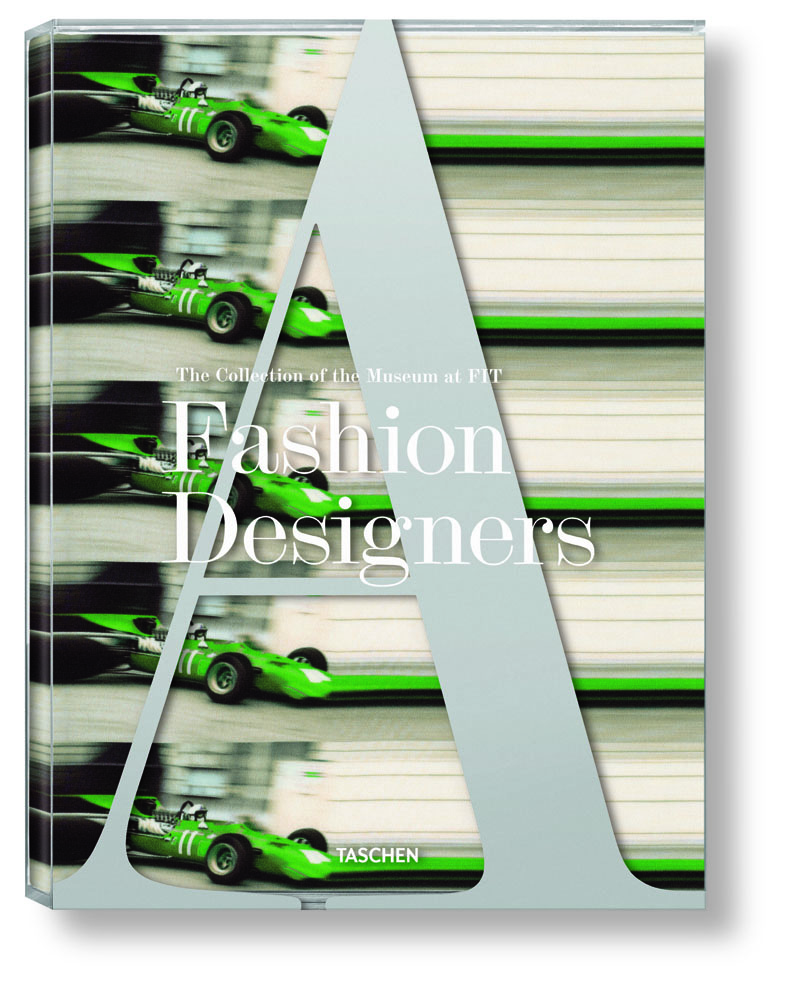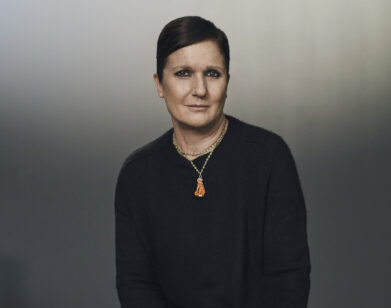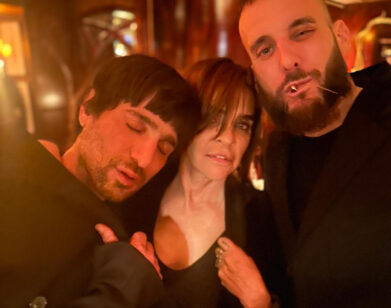Valerie Steele is a Completist
To get the story straight in its encyclopedic Fashion Designers A-Z, Taschen turned to the Museum at the Fashion Institute of Technology and its chief curator and director Valerie Steele to compile a thorough catalog, documenting fashion designers represented in the museum’s collection.
Inside, the 100-plus designer profiles were individually researched by FIT curators. Along with eternal classics like Chanel and Burberry, the book features recent fashion superstars, like Rodarte and Thom Browne. While some others represented have all but disappeared from present-day cultural memory, each contributed a unique legacy of ideas and image to fashion—take, for example, flower-child era designer Giorgio di Sant’Angelo, whom Marc Jacobs cites as an inspiration.
Prefacing the volume is a foreword by International Herald Tribune fashion writer Suzy Menkes and an essay by Steele detailing the history of fashion in museums. The start? An 18th-century concept for a Sphinx-shaped library—apparently, women and their fashions made for a vexing riddle—filled with pull-out boxes of miniaturized clothing.
Centuries later, in the late 1960s, the Museum at FIT bulked up its collection with loans from the Brooklyn Museum’s Edward C. Blum Design Laboratory, but not before receiving donations from the actress Lauren Bacall and the heiress Doris Duke. Today, with four shows a year rotating in two different spaces, it has played something of a smaller, more serious sister to the crowd-pleasing blowouts at the Metropolitan Museum of Art’s Costume Institute.
Why should clothes, ultimately items of utility, be exhibited in a museum? Does that make them art? Fashion savant Steele shared her thoughts on the matter with Interview.
RACHEL SMALL: How did the idea for Fashion A-Z come about?
VALERIE STEELE: Well, I’d always wanted to do a book with Taschen. One of their editors contacted me several years ago and asked about collections that might be suitable to do a book. And I immediately said, “Well, have you considered our collection at the Museum at FIT?” I told her about it, and how we had more than 50,000 garments dating from the 18th century to the present. We decided we would focus on it alphabetically through some of the noted designers whose work is featured in our collection. I initially thought of it as being really sort of a book about the concept of the fashion museum. Yet, of course, people are more interested in fashion designers themselves. So, it incorporates both. It’s organized by designer, but I also have a big 15,000-word essay about the rise of the fashion exhibition and the museum.
SMALL: And what are your were your favorite profiles to write?
STEELE: Oh gosh, that’s really hard to say. Since practically everybody at the museum took part in making this book, it was really a labor of love. I would be hard-pressed to make an invidious selection of one rather than another. But I’m especially proud that we had nice sections on people like Halston, because we do have the world’s best Halston collection, and the world’s best Claire McCardell selection, and I think it was very nice that we were able to feature them.
SMALL: For designers that have been around for decades, how did you consolidate a summary of what their brand represents?
STEELE: It’s hard. The focus is really on things that were in our collection. With some designers, like Chanel and Halston, we had more garments featured, but we tried to keep the essays all more or less the same length. With someone like Chanel, who has a long history, having started in the nineteen-teens and then kept on designing until ’71 when she died, and then having Lagerfeld take over, it’s hard to boil it down. Also, Taschen had the wonderful idea of doing little sketches of each individual designer. I think that was a really nice touch. They hired the illustrator.
SMALL: I loved your portrait as well!
STEELE: Oh yes, that was cute, wasn’t it! You know, it took three guys, like, three hours to make me look that glamorous in the portrait.
SMALL: I’m sure it was a breeze.
STEELE: [laughs]
SMALL: Going back to the collection, who are some of the newer designers in the book?
STEELE: Rodarte and Gareth Pugh were two of the younger designers that we included. We have been acquiring Rodarte since the beginning of their career. We got our first Gareth Pugh piece when we did the Gothic show a few years ago. Then when we did Daphne Guinness, again, we were like, “Oh my God, we need to acquire another piece by Gareth.”
SMALL: What do you think makes a brand really last? And what makes it relevant?
STEELE: That’s tough, because what keeps a brand in the public eye has to do with it continuing to be alive as a brand. If Chanel had not hired Lagerfeld in the end of the ’80s, we probably would not remember Chanel as clearly as we do today. Important as she was, she probably would’ve just blended back into that mass of great women designers in the ’20s and ’30s. So, we do feature the ones who really entered fashion history in a big way, like Chanel, who continued to be famous, but we also brought in people like Augusta Bernard and Louise Boulanger, who were super famous in that period between the First and Second World Wars, but who then went out of business at the end of the ’30s and have been completely forgotten.
SMALL: I feel like fashion penetrates so many different spheres of art. There is fashion photography, there is publishing, obviously, and there are runway shows, which I’ve noticed are becoming more like stage performances. Why do you think fashion design, in particular, has touched so many layers of art?
STEELE: I think fashion is probably one of the most accessible and immediate forms of visual culture. In 1978, when I realized that I wanted to work on fashion, I had gone to Yale to get my Ph.D. in European cultural history. I suddenly realized fashion’s part of culture, and I can do fashion history. All my professors thought this was a really bad idea, that fashion was frivolous and unimportant. I was just like, “I don’t see why you’re not getting it. It’s really important.” And, increasingly over time, people have recognized that it provides such a mirror to the way we think, our values and attitudes. Plus, everybody wears clothes, so the nice thing about working at a fashion museum is everybody from a two-year-old to a grandmother, from someone who is completely uneducated to someone who is an absolute connoisseur, can find something to relate to in a fashion exhibition.
SMALL: Are there any trends in particular right now that you think represent a bigger trend in society?
STEELE: I think that a lot of our fashion history shows do touch on important issues. Fashion and Technology obviously does, because technology is impacting fashion in so many ways, from computer-assisted design to the way we actually purchase clothes online. Similarly, my younger curators did a great fashion history show about a year and a half ago called Eco-Fashion: Going Green. That is a major trend, where people are paying more attention to the sustainable aspects of fashion. But, what was cool about our show was that the curators had to look at eco-fashion over a historical period of more than 200 years. So they looked at how clothes were remade or issues about safety. For example, they had a fabulous green 19th-century dress which was dyed with an incredibly poisonous arsenic dye. Like, whoa! That must’ve been horrible for the workers who made the textiles to work with. And if you wore it, maybe it could wear off on you. We also did a show about exoticism and fashion which looked at 250 years of cross-cultural connections in fashion, about fashion in the West being inspired by Middle Eastern or Asian fashion. And we found amazing examples of that. Like in 1947, the year that India became independent, we found this wonderful Mainbocher, a couture dress that was inspired by and incorporated Indian sari fabric into it.
SMALL: I love how certain patterns now are being created digitally. As far as I can gauge, it started with that Alexander McQueen show that I think was…
STEELE: The Plato’s Atlantis show [spring/summer 2010] was really important for that, absolutely.
SMALL: Yes, those crazy shoes! And now you have, designers like Mary Katrantzou sitting at the computer all night, taking images and just manipulating them. There are no limits anymore.
STEELE: It’s fascinating, isn’t it? And Akris, too, has been in the forefront of doing this computer manipulated photo print.
SMALL: Obviously, putting fashion in a museum context is a big part of what drives you. How did you decide that fashion belongs in a museum?
STEELE: It’s funny, because fashion has been collected and exhibited for many, many years. People were picking up clothing of famous individuals, like Marie Antoinette’s shoe or Napoleon’s hat. I think that part of the resistance to having fashion in museums had to do with it being associated with femininity, and with the female body. So it seemed frivolous and superficial. Yet, as early as the 18th century, some people were recognizing that just as you collected art or historical documents for museums, you, might think about collecting fashion for museums, because it would provide insight into the way people thought about their lives and, and the way they envisioned themselves. One of the coolest things that I found and talked about in the introduction to Fashion A-Z was an 18th century letter published in an English magazine called The Spectator, where the anonymous author fantasized about starting a museum of fashion. He envisioned it being shaped like a Sphinx, which is great because it implies that fashion is feminine and dangerous, irrational and seductive, and so on. Then he talked about how, just like you have books on a library shelf, it would be these little cases and you’d open them up and there would be a doll dressed in the fashions of a particular period. But my favorite part of it is he also suggested, I assume facetiously, that they hire as a curator for this fashion museum some bankrupt flop who had spent all his money on clothes, but he knew about clothes—kind of a wonderful fantasy idea of the first fashion curator.
SMALL: What are your thoughts on how fashion museums place the garments themselves in a broader, social, economic, and even aesthetic, or art historical context?
STEELE: Well, we think that the more you know about the significance of clothes culturally, the more interesting they are. We certainly don’t neglect the aesthetic aspects of clothes, and we’ve had some shows which are real kind of connoisseur shows, like the one on Madame Grès. But, I feel that what sets us apart is that we are not only talking about clothes as kind of art objects created by an artist designer, but also we’re talking about the various meanings that clothes have in the world, and how that changes and how we kind of create meanings around clothes. When we did our corset show, I wanted to show why women wore corsets for 400 years. It’s wasn’t just ladies of leisure wearing corsets, but also the housemaids, who were down on their hands and knees scrubbing, were wearing cheap corsets that gave them a fashionable silhouette. It didn’t have expensive whale bone. It had cheap metal stays, and it wasn’t made of beautiful colored silk and satin, just cheap, sturdy cotton twill. But still it gave them that fashionable shape.
FASHION DESIGNERS A-Z IS NOW AVAILABLE AS A SERIES OF SIX LIMITED DESIGNER EDITIONS, EACH OF WHICH IS BOUND IN FABRIC CREATED BY A DESIGNER (AKRIS, ETRO, PRADA, MISSONI, STELLA MCCARTNEY, AND DIANE VON FURSTENBERG). FOR MORE INFORMATION, VISIT TASCHEN’S WEBSITE.







